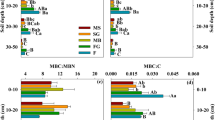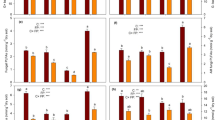Abstract
Purpose
The objectives of this study were to investigate (i) how the changes in cultivation pattern of vegetable affect soil microbial communities and (ii) the relationships between soil physico-chemical properties and microbial community structure.
Materials and methods
Soil samples were collected from fields growing vegetable crops with various times of plastic-greenhouse cultivation (0, 1, 4, 7 and 15 years, respectively). Phospholipid fatty acid (PLFA) analysis was conducted to reveal the soil microbial community of the test soils.
Results and discussion
The open-field soil had the highest total PLFAs amount. Although the Shannon-Weaver index was also highest in the open-field soil, the difference was not significant. Plastic-greenhouse cultivation decreased PLFAs species diversity and richness. Cluster analysis and principal component analysis (PCA) of the PLFA profiles revealed distinct groupings at different times during plastic-greenhouse cultivation.
Conclusions
Ultimately, PLFA analyses showed that long-term plastic-greenhouse cultivation make the physiological status of soil microbial community worse and increased stress level of microorganisms. And soil microbial community was significantly affected by field water capacity and water-soluble organic carbon. The study highlights the potential risk of long-term plastic-greenhouse cultivation to soil microbial community.



Similar content being viewed by others
References
Agricultural Chemistry Committee of China (1983) Conventional methods of soil and agricultural chemistry analysis. Science Press, Beijing
Allison SD, Treseder KK (2008) Warming and drying suppress microbial activity and carbon cycling in boreal forest soils. Glob Change Biol 14:2898–2909
Barnard R, Leadley PW, Hungate BA (2005) Global change, nitrification, and denitrification: a review. Glob Biogeochem Cycles 19:1–13
Boehm MJ, Wu TY, Stone AG, Kraakman B, Iannotti DA, Wilson GE, Madden LV, Hoitink H (1997) Cross-polarized magic-angle spinning C-13 nuclear magnetic resonance spectroscopic characterization of soil organic matter relative to culturable bacterial species composition and sustained biological control of Pythium root rot. Appl Environ Microb 63:162–168
Bossio DA, Scow KM, Gunapala N, Graham KJ (1998) Determinants of soil microbial communities: effects of agricultural management, season, and soil type on phospholipid fatty acid profiles. Microb Ecol 36:1–12
Brockett B, Prescott CE, Grayston SJ (2012) Soil moisture is the major factor influencing microbial community structure and enzyme activities across seven biogeoclimatic zones in western Canada. Soil Biol Biochem 44:9–20
Buckley DH, Schmid TM (2001) The structure of microbial communities in soil and the lasting impact of cultivation. Microb Ecol 42:11–21
Chang J, Wu, X, Wang Y, Meyerson, LA, Gu BJ, Min Y, Xue H, Peng CH, Ge Y (2013) Does growing vegetables in plastic greenhouses enhance regional ecosystem services beyond the food supply? Front Ecol Environ 11:43–49
De Vries FT, Hoffland E, Van Eekeren N, Brussaard L, Bloem J (2006) Fungal/bacterial ratios in grasslands with contrasting nitrogen management. Soil Biol Biochem 38:2092–2103
Ellis RJ, Neish B, Trett MW, Best JG, Weightman AJ, Morgan P, Fry JC (2001) Comparison of microbial and meiofaunal community analyses for determining impact of heavy metal contamination. J Microbiol Meth 45:171–185
El-Tarabily KA, Nassar AH, Sivasithamparam K (2008) Promotion of growth of bean (Phaseolus vulgaris L.) in a calcareous soil by a phosphate-solubilizing, rhizosphere-competent isolate of Micromonospora endolithica. Appl Soil Ecol 39:161–171
Falkowski PG, Fenchel T, Delong EF (2008) The microbial engines that drive Earth’s biogeochemical cycles. Science 320:1034–1039
Fierer N, Schimel JP, Holden PA (2003) Variations in microbial community composition through two soil depth profiles. Soil Biol Biochem 35:167–176
Gans J, Wolinsky M, Dunbar J (2005) Computational improvements reveal great bacterial diversity and high metal toxicity in soil. Science 309:1387–1390
Han JP, Luo YH, Yang LP, Liu XM, Wu LS, Xu JM (2014) Acidification and salinization of soils with different initial pH under greenhouse vegetable cultivation. J Soils Sediments 14:1683–1692
He Y, Xu JM, Ma ZH, Wang HZ, Wu YP (2007) Profiling of PLFA: implications for nonlinear spatial gradient of PCP degradation in the vicinity of Lolium perenne L. roots. Soil Biol Biochem 39:1121–1129
He Y, Ding N, Shi JC, Wu M, Liao H, Xu JM (2013) Profiling of microbial PLFAs: implications for interspecific interactions due to intercropping which increase phosphorus uptake in phosphorus limited acidic soils. Soil Biol Biochem 57:625–634
Hedlund K (2002) Soil microbial community structure in relation to vegetation management on former agricultural land. Soil Biol Biochem 34:1299–1307
Heining B (1963) A pressure membrane apparatus. J Agr Eng Res 8:48–49
Hines J, Megonigal JP, Denno RF (2006) Nutrient subsidies to belowground microbes impact aboveground food web interactions. Ecology 87:1542–1555
Hinojosa MB, Carreira JA, Garcia-Ruiz R, Dick RP (2005) Microbial response to heavy metal-polluted soils: community analysis from phospholipid-linked fatty acids and ester-linked fatty acids extracts. J Environ Qual 34:1789–1800
Jangid K, Williams MA, Franzluebbers AJ, Schmidt TM, Coleman DC, Whitman WB (2011) Land-use history has a stronger impact on soil microbial community composition than aboveground vegetation and soil properties. Soil Biol Biochem 43:2184–2193
Keynan A, Sandler N (1983) Spore research in historical perspective. In: Hurst A, Gould GW (eds) The bacterial spore, vol 2. Academic, New York, pp 1–48
Li D, Wu Z, Liang C, Chen L (2004) Characteristics and regulation of greenhouse soil environment. Chin J Ecology 23:192–197
Mader P, Fliessbach A, Dubois D, Gunst L, Fried P, Niggli U (2002) Soil fertility and biodiversity in organic farming. Science 296:1694–1697
Marschner P, Kandeler E, Marschner B (2003) Structure and function of the soil microbial community in a long-term fertilizer experiment. Soil Biol Biochem 35:453–461
Pina RG, Cervantes C (1996) Microbial interactions with aluminium. Biometals 9:311–316
Sharpley A, Daniel TC, Sims JT, Pote DH (1996) Determining environmentally sound soil phosphorus levels. J Soil Water Conserv 51:160–166
Song H, Guo JH, Ren T, Chen Q, Li BG, Wang JG (2012) Increase of soil pH in a solar greenhouse vegetable production system. Soil Sci Soc Am J 76:2074–2082
Sun R, Dong ZX, Zhang XX, Li Y, Cao H, Cui ZL (2011) Rice to vegetables: short- versus long-term impact of land-use change on the indigenous soil microbial community. Microb Ecol 62:474–485
Wakelin SA, Macdonald LM, Rogers SL, Gregg AL, Bolger TP, Baldock JA (2008) Habitat selective factors influencing the structural composition and functional capacity of microbial communities in agricultural soils. Soil Biol Biochem 40:803–813
Wang JL, He WS (2005) Variability of N, P and K contents of greenhouse soils in different regions of Ningxia. Soil 37:630–634 (in Chinese)
Wang P, Wang HZ, Wu L, Di H, He Y, Xu JM (2012) Influence of black carbon addition on phenanthrene dissipation and microbial community in soil. Environ Pollut 161:121–127
White DC, Macnaughton SJ (1997) Chemical and molecular approaches for rapid assessment of the biological status of soils. In: Pankhurst C, Doube BM, Gupta VVSR (eds) Biological indicators of soil health. CAB International, Wallingford, pp 371–396
White DC, Davis WM, Nickels JS, King JD, Bobbie RJ (1979) Determination of the sedimentary microbial biomass by extractable lipid phosphate. Oecologia 40:51–62
Wu YP, Ma B, Zhou L, Wang HZ, Xu JM, Kemmitt S, Brookes PC (2009) Changes in the soil microbial community structure with latitude in eastern China, based on phospholipid fatty acid analysis. Appl Soil Ecol 43:234–240
Wu LK, Li ZF, Li J, Khan MA, Huang W, Zhang ZY, Lin WX (2013) Assessment of shifts in microbial community structure and catabolic diversity in response to Rehmannia glutinosa monoculture. Appl Soil Ecol 67:1–9
Xue D, Yao HY, Ge DY, Huang CY (2008) Soil microbial community structure in diverse land use systems: a comparative study using biolog, DGGE, and PLFA analyses. Pedosphere 18:653–663
Xue C, Huang QW LN, Gao XL (2011) Analysis, regulation and high-throughout sequencing of soil microflora in mono-cropping system. Acta Pedol Sin 48:612–618 (in Chinese)
Yan M, Pang JM, Jiao XY, Wu AL, Wang LG, Wang JS (2012) Variation of microflora and nutrient content in cucumber rhizosphere of continuous cropping in greenhouse. Journal of Shanxi Agricultural Science 40:1296–1298 (in Chinese)
Yao HY, Jiao XD, Wu FZ (2006) Effects of continuous cucumber cropping and alternative rotations under protected cultivation on soil microbial community diversity. Plant Soil 284:195–203
Yu JQ, Shou SY, Qian YR, Zhu ZZ, Hu WH (2000) Autotoxic potential of cucurbit crops. Plant Soil 223:147–151
Zak JC, Willig MR, Moorhead DL, Wildman HG (1994) Functional diversity of microbial communities: a quantitative approach. Soil Biol Biochem 26:1101–1108
Zaman M, Di HJ, Cameron KC, Frampton CM (1999) Gross nitrogen mineralization and nitrification rates and their relationships to enzyme activities and the soil microbial biomass in soils treated with dairy shed effluent and ammonium fertilizer at different water potentials. Biol Fert Soils 29:178–186
Acknowledgments
This work was supported by the National Natural Science Foundation of China (no. 40971255), and the Fundamental Research Funds for the Central Universities.
Author information
Authors and Affiliations
Corresponding author
Ethics declarations
Conflict of interest
The authors declare that they have no conflict of interest.
Additional information
Responsible editor: Chengrong Chen
Rights and permissions
About this article
Cite this article
Yao, Z., Xing, J., Gu, H. et al. Development of microbial community structure in vegetable-growing soils from open-field to plastic-greenhouse cultivation based on the PLFA analysis. J Soils Sediments 16, 2041–2049 (2016). https://doi.org/10.1007/s11368-016-1397-2
Received:
Accepted:
Published:
Issue Date:
DOI: https://doi.org/10.1007/s11368-016-1397-2




